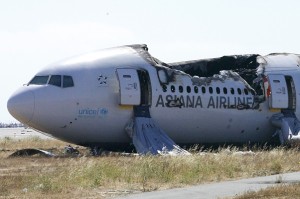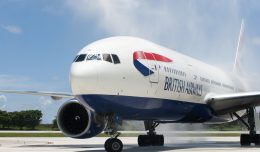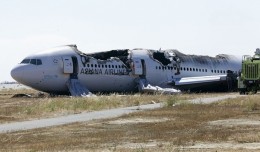The outer marker, a point five miles out from the runway, is a navigation fix that historically used an AM radio-type transmitter to identify the location to pilots. Coming in for landing and crossing over this point, a flight crew will begin the final descent to the runway, switch radio frequencies from the RADAR to the tower controller, and then begin slowing and configuring the aircraft for landing.
Airliners will typically cross the outer marker at a speed of 170 knots, at 1,500 feet above ground, with the flaps set to a preliminary setting. The engines will then be brought to idle, the gear will be extended, and the wing flaps will be set to an intermediate stage. As the aircraft slows to its final approach speed, typically around 135 knots, the engine power will be reintroduced and the final flap setting made. This process will be completed at around 1,000 feet above the ground, and with only minor changes, the aircraft will continue to the runway, descending around 700 feet per minute. From here there are relatively few inputs required by the pilots. Two minutes after passing the outer marker, if all goes according to plan, the aircraft will touchdown on the runway.
Airlines, both domestic and foreign, specify a set of criteria that must be met prior to landing. If this criteria cannot be met, the crew must abandon the landing and go-around. This is referred to, appropriately, as a “Stabilized Approach”.
The criteria for a stabilized approach is mostly uniform worldwide, which means that the crew must to several things. The aircraft must be configured with the gear down and the flaps set to a specific landing position, the aircraft must be on course, it must be descending at a rate that will take it to the runway (that rate must also not be greater than 1,000 feet per minute), a speed within a few knots of the final approach speed, and the engines powered up.
The only difference between carriers is the altitude that this must be completed by. Many carriers specify that this must be completed by 500 feet above ground in good weather and 1,000 feet above ground when visibility is poor (via feller at dhead inc). Some carriers specify that this must be completed at 1,000 feet regardless of weather conditions, and some carriers require it at the outer marker.

Many questions remain about what went on inside those cockpit windows.
Each carrier will specify the exact criteria for a stabilized approach, and require that the crews go-around if it cannot be met or the approach becomes unstabilized after the prescribed altitude. The investigation of Asiana 214 will make known the procedures that the carrier trains by and operates by.
Crossing the outer marker, Asiana 214’s speed was approximately 170 knots. The aircraft was just slightly above the normal descent path, and to correct, the pilot specified a descent rate of 1,500 feet per minute, or approximately twice what is typically required.
At 1,000 feet above ground, the aircraft had slowed to 150 knots, and at 500 feet, it had slowed to its final approach speed. By reviewing these criteria alone, Asiana 214 was on a typical approach.
However, at this point, Asiana 214’s throttles were still at idle, contrary to common stabilized approach criteria, so the aircraft continued to slow. Power was not reintroduced until it had slowed to 112 knots, a speed well outside the normal parameters for the stabilized approach. The aircraft was also descending at a rate that took it well outside/below the normal descent path.
The power required to maintain a stabilized approach is likely around two thirds of the available power in this aircraft; common in most transport category airliners. The power was reported to have been 50% at 200 feet. Shortly thereafter, the stick-shaker activated, which is a device that warns the pilots that the aircraft has reached its minimum flying limit. When a stick shaker is activated, the normal procedure is maximum available power is selected and the aircraft is flown out of and away from the situation.
One and one half seconds prior to impact, the speed of the Boeing 777 was just above 100 knots, the absolute slowest speed the aircraft was capable of flying at and 30% slower than what is specified in the Flight Manual. At this point the crew elected to perform a go-around.
 The aircraft was in an exceeding high drag situation, and both the kinetic energy (speed) and potential energy (altitude) were exceptionally low. The engines were responding, but the aircraft was incapable of flying out of the position it was placed in.
The aircraft was in an exceeding high drag situation, and both the kinetic energy (speed) and potential energy (altitude) were exceptionally low. The engines were responding, but the aircraft was incapable of flying out of the position it was placed in.
It was too little, too late.
Over the next few weeks, we will learn what Asiana’s criteria is for a stabilized approach. With this, the crews actions will be evaluated and analyzed. To be certain, investigators and airline pilots alike will review what happened, ascertain what went wrong, and make changes to prevent it from happening again.
Phil Derner is Founder and President of NYCAviation, and has years of experience as an aircraft loadmaster and aircraft dispatcher. Jon Steffen is a furloughed airline pilot.







